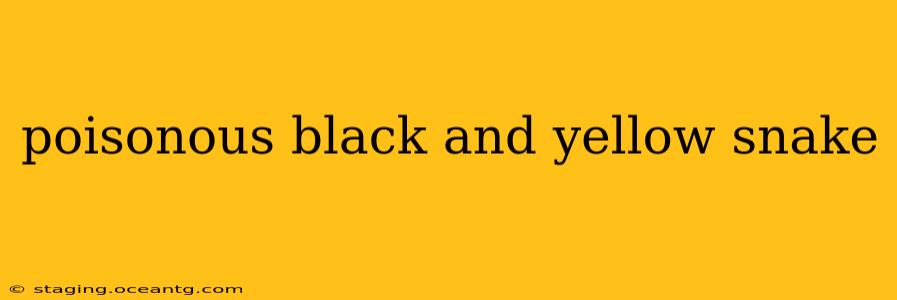The combination of black and yellow markings on a snake immediately raises alarm bells for many. While this coloration is a warning signal in nature, indicating potential toxicity, it's crucial to understand that not all black and yellow snakes are equally dangerous. Several species around the world exhibit this striking pattern, each with its unique venom potency and behavior. This article will explore some of the most common poisonous black and yellow snakes, their habitats, and how to stay safe when encountering them.
What are some examples of poisonous black and yellow snakes?
Several snake species sport a black and yellow or black and gold pattern. However, the level of danger varies significantly. Here are a few examples:
-
Eastern Coral Snake (Micrurus fulvius): This North American species is highly venomous. Its bright red, black, and yellow bands are a classic warning. Critically, it's important to distinguish it from its harmless mimics, like the scarlet kingsnake. Coral snakes have red bands touching yellow bands; scarlet kingsnakes have red bands touching black bands – "red on yellow, kill a fellow; red on black, venom lack." This rhyme, while helpful, shouldn't be relied upon solely for identification.
-
Western Coral Snake (Micrurus tener): Found in the southwestern United States and Mexico, the Western Coral Snake is also highly venomous. Its banding pattern is similar to the Eastern Coral Snake, but there are subtle variations.
-
Spectacled Cobra (Naja kaouthia): While not always exhibiting a bold black and yellow pattern, some subspecies display a mix of black, yellow, and brown hues. This cobra is found in Southeast Asia and is highly venomous.
-
Banded Krait (Bungarus fasciatus): With its striking black and yellow bands, the Banded Krait is another highly venomous species found in Southeast Asia.
How can I tell if a black and yellow snake is poisonous?
Identifying poisonous snakes solely based on color is unreliable and dangerous. Many harmless snakes mimic the coloration of venomous species as a defense mechanism. Never attempt to handle any snake you suspect might be venomous. Accurate identification requires a trained eye and careful observation of several characteristics, including:
- Banding patterns: The precise arrangement and width of bands can help distinguish venomous from non-venomous species.
- Head shape: Venomous snakes often have distinct head shapes, such as a triangular head (though this isn't always reliable).
- Pupil shape: While not universally applicable, some venomous snakes possess elliptical pupils.
- Scales: The arrangement and type of scales can be crucial for identification.
Where do black and yellow poisonous snakes live?
The geographical distribution of poisonous black and yellow snakes varies greatly depending on the species. For example:
- Eastern and Western Coral Snakes: Found in specific regions of North America and Mexico.
- Spectacled Cobras: Inhabit parts of Southeast Asia.
- Banded Kraits: Primarily found in Southeast Asia.
What should I do if I see a black and yellow snake?
Your best course of action is to avoid the snake completely. Maintain a safe distance, and never attempt to handle it. If you are bitten, seek immediate medical attention. Note any features of the snake (if possible and safe to do so) to aid in identification for medical professionals. Calling local wildlife authorities or experts might be beneficial if the snake poses a threat to others.
What first aid should I administer for a venomous snake bite?
Do not attempt to suck out the venom. This is an outdated and ineffective method. Instead, follow these guidelines:
- Stay calm: Panic can worsen the situation.
- Immobilize the affected limb: Keep the bitten area below heart level.
- Remove any jewelry or restrictive clothing: Swelling can occur rapidly.
- Seek immediate medical attention: Get to a hospital or emergency room as quickly as possible.
Remember, accurate identification and prompt medical treatment are crucial when dealing with a venomous snakebite. Your safety is paramount; always prioritize avoiding contact and seeking professional help when necessary.
